Navigating Environmental Concerns: Unveiling the Role of Economic Governance, Energy Transition, and Population Aging on Transport-Based CO2 Emissions in China
Abstract
1. Introduction
2. Literature Reviews
2.1. ECOG and Environment Sustainability
2.2. POPAGE and Environment Sustainability
2.3. FI and Environment Sustainability
2.4. Knowledge Gap
3. Methodology
3.1. Model Specifications
3.2. Data Source
3.3. Econometric Methods
- represent the coefficient of the study.
- An additive term reflects the fixed effects in the model.
- The representative function R(Z) is used for the characteristic variant, and it is defined as follows:
4. Results and Discussion
4.1. Descriptive Statistics
4.2. Unit Root
4.3. BDS Test
4.4. Diagnostic Test
4.5. Johansen Cointegration Test
4.6. Main Results
4.7. Discussion
4.8. Robustness Results (BSQR)
4.9. Granger Causality
5. Conclusions and Policy Implication
5.1. Conclusions
5.2. Theoretical Implication
5.3. Managerial Implications
6. Limitations and Future Direction
Author Contributions
Funding
Data Availability Statement
Conflicts of Interest
Abbreviations
| TCO2E | Transport-related CO2 emissions |
| ECOG | Economic governance |
| FI | Financial innovation |
| POPAGE | Population ageing |
| UNCCC | United Nations Climate Change Conference |
| SDGs | 17 Sustainable Development Goals |
| ENT | Energy transition |
| HI | Human capital index |
| GDP | Gross domestic product |
| MMQR | Method of Moments Quantile Regression |
| BSQR | Bootstrap quantile regression |
| GHGs | Green gas emissions |
| OECD | Organization for Economic Co-Operation and Development |
| ECOWAS | Economic Community of West African States |
References
- Ahmad, M.; Dai, J.; Mehmood, U.; Abou, M. Renewable energy transition, resource richness, economic growth, and environmental quality: Assessing the role of financial globalization. Renew. Energy 2023, 216, 119000. [Google Scholar] [CrossRef]
- Adebayo, T.S.; Adedoyin, F.F.; Kirikkaleli, D. Toward a sustainable environment: Nexus between economic growth, renewable energy use, forested area, and carbon emissions in Malaysia. Resour. Conserv. Recycl. Adv. 2023, 15, 200096. [Google Scholar] [CrossRef]
- Jianguo, D.; Rasool, Y.; Ali, K.; Kashif, U.; Ahmed, Z. Can financial innovation and environmental policy curb transport-based CO2 emissions? An advanced panel analysis. Geol. J. 2024, 59, 1262–1279. [Google Scholar] [CrossRef]
- Naseem, S.; Kashif, U.; Rasool, Y.; Akhtar, M. The impact of financial innovation, green energy, and economic growth on transport-based CO2 emissions in India: Insights from QARDL approach. Environ. Dev. Sustain. 2023, 26, 28823–28842. [Google Scholar] [CrossRef]
- Sohail, M.T.; Ullah, S.; Majeed, M.T. Transportation taxes and CO2 emissions nexus in BCIST economies: Implication for environmental sustainability. Energy Environ. 2024, 35, 2829–2845. [Google Scholar] [CrossRef]
- Kwilinski, A.; Lyulyov, O.; Pimonenko, T. Reducing transport sector CO2 emissions patterns: Environmental technologies and renewable energy. J. Open Innov. Technol. Mark. Complex. 2024, 10, 100217. [Google Scholar] [CrossRef]
- Luderer, G.; Madeddu, S.; Merfort, L.; Ueckerdt, F.; Pehl, M.; Pietzcker, R.; Rottoli, M.; Schreyer, F.; Bauer, N.; Baumstark, L.; et al. Impact of declining renewable energy costs on electrification in low-emission scenarios. Nat. Energy 2021, 7, 32–42. [Google Scholar] [CrossRef]
- Jianguo, D.; Ali, K.; Alnori, F.; Ullah, S. The nexus of financial development, technological innovation, institutional quality, and environmental quality: Evidence from OECD economies. Environ. Sci. Pollut. Res. 2022, 29, 58179–58200. [Google Scholar] [CrossRef]
- Nguyen, Q.K.; Dang, V.C. Renewable energy consumption, carbon dioxide emission and financial stability: Does institutional quality matter? Appl. Econ. 2023, 56, 8820–8837. [Google Scholar] [CrossRef]
- Chishti, M.Z.; Sinha, A. Do the shocks in technological and financial innovation influence the environmental quality? Evidence from BRICS economies. Technol. Soc. 2022, 68, 101828. [Google Scholar] [CrossRef]
- Huo, W.; Zaman, B.U.; Zulfiqar, M.; Kocak, E.; Shehzad, K. How do environmental technologies affect environmental degradation? Analyzing the direct and indirect impact of financial innovations and economic globalization. Environ. Technol. Innov. 2023, 29, 102973. [Google Scholar] [CrossRef]
- Rasool, Y.; Jianguo, D.; Ali, K. Exploring the linkage between globalization and environmental degradation: A disaggregate analysis of Indonesia. Environ. Dev. Sustain. 2023, 26, 16887–16915. [Google Scholar] [CrossRef]
- IEA. World Energy Outlook 2019; International Energy Agency: Paris, France, 2019; Volume 1.
- Ali, K.; Jianguo, D.; Kirikkaleli, D. Modeling the natural resources and financial inclusion on ecological footprint: The role of economic governance institutions. Evidence from ECOWAS economies. Resour. Policy 2022, 79, 103115. [Google Scholar] [CrossRef]
- Akhtar, S.; Li, C.; Sohu, J.M.; Rasool, Y.; Hassan, M.I.U.; Bilal, M. Unlocking green innovation and environmental performance: The mediated moderation of green absorptive capacity and green innovation climate. Environ. Sci. Pollut. Res. Int. 2024, 31, 4547–4562. [Google Scholar] [CrossRef]
- Kashif, U.; Shi, J.; Naseem, S.; Dou, S.; Zahid, Z. ICT service exports and CO2 emissions in OECD countries: The moderating effect of regulatory quality. Econ. Change Restruct. 2024, 57, 94. [Google Scholar] [CrossRef]
- Ali, K.; Hongbing, H.; Liew, C.Y.; Jianguo, D. Governance Perspective and the Effect of Economic Policy Uncertainty on Financial Stability: Evidence from Developed and Developing Economies; Springer: New York, NY, USA, 2023; ISBN 0123456789. [Google Scholar]
- Obobisa, E.S.; Chen, H.; Mensah, I.A. The impact of green technological innovation and institutional quality on CO2 emissions in African countries. Technol. Forecast. Soc. Change 2022, 180, 121670. [Google Scholar] [CrossRef]
- Wang, Q.; Li, L. The effects of population aging, life expectancy, unemployment rate, population density, per capita GDP, urbanization on per capita carbon emissions. Sustain. Prod. Consum. 2021, 28, 760–774. [Google Scholar] [CrossRef]
- Yang, T.; Wang, Q. The nonlinear effect of population aging on carbon emission-Empirical analysis of ten selected provinces in China. Sci. Total Environ. 2020, 740, 140057. [Google Scholar] [CrossRef]
- Jianguo, D.; Cheng, J.; Ali, K. Modelling the green logistics and financial innovation on carbon neutrality goal, a fresh insight for BRICS-T. Geol. J. 2023, 58, 2742–2756. [Google Scholar] [CrossRef]
- Umar, M.; Ji, X.; Kirikkaleli, D.; Xu, Q. COP21 Roadmap: Do innovation, financial development, and transportation infrastructure matter for environmental sustainability in China? J. Environ. Manag. 2020, 271, 111026. [Google Scholar] [CrossRef]
- Koenker, R.; Zhao, Q. L-Estimation for linear heteroscedastic models. J. Nonparametr. Stat. 1994, 3, 223–235. [Google Scholar] [CrossRef]
- Liu, Y.; Feng, C. Decouple transport CO2 emissions from China’s economic expansion: A temporal-spatial analysis. Transp. Res. Part D Transp. Environ. 2020, 79, 102225. [Google Scholar] [CrossRef]
- Aminzadegan, S.; Shahriari, M.; Mehranfar, F.; Abramović, B. Factors affecting the emission of pollutants in different types of transportation: A literature review. Energy Rep. 2022, 8, 2508–2529. [Google Scholar] [CrossRef]
- Avotra, A.A.R.N.; Nawaz, A. Asymmetric impact of transportation on carbon emissions influencing SDGs of climate change. Chemosphere 2023, 324, 138301. [Google Scholar] [CrossRef]
- Zhao, C.; Wang, K.; Dong, X.; Dong, K. Is smart transportation associated with reduced carbon emissions? The case of China. Energy Econ. 2022, 105, 105715. [Google Scholar] [CrossRef]
- Ibrahim, R.L.; Ajide, K.B. The dynamic heterogeneous impacts of nonrenewable energy, trade openness, total natural resource rents, financial development and regulatory quality on environmental quality: Evidence from BRICS economies. Resour. Policy 2021, 74, 102251. [Google Scholar] [CrossRef]
- Ali, K.; Jianguo, D.; Kirikkaleli, D.; Oláh, J.; Altuntaş, M.; Ali, K. Do green technological innovation, financial development, economic policy uncertainty, and institutional quality matter for environmental sustainability? uncertainty, and institutional quality matter for environmental sustainability? All Earth 2023, 35, 82–101. [Google Scholar] [CrossRef]
- Zahid, Z.; Zhang, J.; Shahzad, M.A.; Junaid, M.; Shrivastava, A. Green Synergy: Interplay of corporate social responsibility, green intellectual capital, and green ambidextrous innovation for sustainable performance in the industry 4.0 era. PLoS ONE 2024, 19, e0306349. [Google Scholar] [CrossRef]
- Abid, M. Does economic, financial and institutional developments matter for environmental quality? A comparative analysis of EU and MEA countries. J. Environ. Manag. 2017, 188, 183–194. [Google Scholar] [CrossRef]
- Nwani, C.; Adams, S. Environmental cost of natural resource rents based on production and consumption inventories of carbon emissions: Assessing the role of institutional quality. Resour. Policy 2021, 74, 102282. [Google Scholar] [CrossRef]
- Fremstad, A.; Paul, M. The Impact of a Carbon Tax on Inequality. Ecol. Econ. 2019, 163, 88–97. [Google Scholar] [CrossRef]
- Zahid, Z.; Zhang, J.; Gao, C.; Oláh, J. ICT-Driven Strategies for Enhancing Energy Efficiency in G20 Economies: Moderating the Role of Governance in Achieving Environmental Sustainability. Energies 2025, 18, 685. [Google Scholar] [CrossRef]
- Pushak, T.; Tiongson, E.R.; Varoudakis, A. Public Finance, Governance, and Growth in Transition Economies: Empirical Evidence from 1992–2004. In World Bank Policy Research Working Paper; World Bank: Washington, DC, USA, 2007; pp. 1–31. [Google Scholar]
- Al-Mulali, U.; Ozturk, I. The effect of energy consumption, urbanization, trade openness, industrial output, and the political stability on the environmental degradation in the MENA (Middle East and North African) region. Energy 2015, 84, 382–389. [Google Scholar] [CrossRef]
- Akhtar, M.; Haris, M.; Naveed, H.M.; Rasool, Y.; Al-Faryan, M.A.S. Electricity shortfalls and financial leverage of listed firms in Pakistan. Util. Policy 2024, 87, 101719. [Google Scholar] [CrossRef]
- Yang, X.; Li, N.; Mu, H.; Pang, J.; Zhao, H.; Ahmad, M. Study on the long-term impact of economic globalization and population aging on CO2 emissions in OECD countries. Sci. Total Environ. 2021, 787, 147625. [Google Scholar] [CrossRef]
- Wang, Q.; Wang, L. The nonlinear effects of population aging, industrial structure, and urbanization on carbon emissions: A panel threshold regression analysis of 137 countries. J. Clean. Prod. 2021, 287, 125381. [Google Scholar] [CrossRef]
- Kim, J.; Lim, H.; Jo, H.H. Do aging and low fertility reduce carbon emissions in Korea? Evidence from IPAT augmented EKC analysis. Int. J. Environ. Res. Public Health 2020, 17, 2972. [Google Scholar] [CrossRef]
- Zhang, C.; Tan, Z. The relationships between population factors and China’s carbon emissions: Does population aging matter? Renew. Sustain. Energy Rev. 2016, 65, 1018–1025. [Google Scholar] [CrossRef]
- Liu, Y.; Gao, C.; Lu, Y. The impact of urbanization on GHG emissions in China: The role of population density. J. Clean. Prod. 2017, 157, 299–309. [Google Scholar] [CrossRef]
- Kirikkaleli, D.; Adebayo, T.S. Do renewable energy consumption and financial development matter for environmental sustainability? New global evidence. Sustain. Dev. 2021, 29, 583–594. [Google Scholar] [CrossRef]
- Shabir, M. Does Financial Inclusion Promote Environmental Sustainability: Analyzing the Role of Technological Innovation and Economic Globalization. J. Knowl. Econ. 2022, 15, 19–46. [Google Scholar] [CrossRef]
- Kirikkaleli, D.; Güngör, H.; Adebayo, T.S. Consumption-based carbon emissions, renewable energy consumption, financial development and economic growth in Chile. Bus. Strateg. Environ. 2022, 31, 1123–1137. [Google Scholar] [CrossRef]
- Yu, M.; Tsai, F.; Jin, H.; Zhang, H. Digital finance and renewable energy consumption: Evidence from China. Financ. Innov. 2022, 8, 58. [Google Scholar] [CrossRef]
- Tay, L.Y.; Tai, H.T.; Tan, G.S. Digital financial inclusion: A gateway to sustainable development. Heliyon 2022, 8, e09766. [Google Scholar] [CrossRef]
- Fareed, Z.; Rehman, M.A.; Adebayo, T.S.; Wang, Y.; Ahmad, M.; Shahzad, F. Financial inclusion and the environmental deterioration in Eurozone: The moderating role of innovation activity. Technol. Soc. 2022, 69, 101961. [Google Scholar] [CrossRef]
- Luo, R.; Ullah, S.; Ali, K. Pathway towards sustainability in selected Asian countries: Influence of green investment, technology innovations, and economic growth on CO2 emission. Sustainability 2021, 13, 12873. [Google Scholar] [CrossRef]
- Paparoditis, E.; Politis, D.N. The asymptotic size and power of the augmented Dickey–Fuller test for a unit root. Econom. Rev. 2013, 37, 955–973. [Google Scholar] [CrossRef]
- Phillips, P.C.B.; Perron, P. Testing for a unit root in time series regression. Biometrika 1988, 75, 335–346. [Google Scholar] [CrossRef]
- Elliott, G.; Rothenberg, T.J.; Stock, J.H. Efficient Tests for an Autoregressive Unit Root. Econometrica 1996, 64, 813. [Google Scholar] [CrossRef]
- Machado, J.A.F.; Santos Silva, J.M.C. Quantiles via moments. J. Econom. 2019, 213, 145–173. [Google Scholar] [CrossRef]
- Efron, B.; Tibshirani, R.J. An Introduction to the Bootstrap; Monographs on Statistics and Applied Probability, No. 57; Chapman and Hall: London, UK, 1994; 436p. [Google Scholar]
- Kapusuzoglu, A.; Karacaer Ulusoy, M. The interactions between agricultural commodity and oil prices: An empirical analysis. Agric. Econ. 2015, 61, 410–421. [Google Scholar] [CrossRef]
- Lajdova, Z.; Lajda, J.; Bielikv, P. The impact of the biogas industry on agricultural sector in Germany. Agric. Econ. 2016, 62, 1–8. [Google Scholar] [CrossRef]
- MacKinnon, J.G.; Haug, A.A.; Michelis, L. Numerical Distribution Functions of Likelihood Ratio Tests for Cointegration. J. Appl. Econom. 1999, 14, 563–577. [Google Scholar] [CrossRef]
- Wang, Q.; Ge, Y.; Li, R. Does improving economic efficiency reduce ecological footprint? The role of financial development, renewable energy, and industrialization. Energy Environ. 2023, 36, 755. [Google Scholar] [CrossRef]
- Yu, Y.; Deng, Y.; Chen, F. Impact of population aging and industrial structure on CO2 emissions and emissions trend prediction in China. Atmos. Pollut. Res. 2018, 9, 446–454. [Google Scholar] [CrossRef]
- Meng, Y.; Wu, H.; Wang, Y.; Duan, Y. International trade diversification, green innovation, and consumption-based carbon emissions: The role of renewable energy for sustainable development in BRICST countries. Renew. Energy 2022, 198, 1243–1253. [Google Scholar] [CrossRef]
- Zhen, Z.; Ullah, S.; Shaowen, Z.; Irfan, M. How do renewable energy consumption, financial development, and technical efficiency change cause ecological sustainability in European Union countries? Energy Environ. 2022, 34, 2478–2496. [Google Scholar] [CrossRef]
- Lee, C.C.; Yuan, Z.; Lee, C.C.; Chang, Y.F. The impact of renewable energy technology innovation on energy poverty: Does climate risk matter? Energy Econ. 2022, 116, 106427. [Google Scholar] [CrossRef]
- Wang, Z.; Rasool, Y.; Asghar, M.M.; Wang, B. Dynamic linkages among CO2 emissions, human development, financial development, and globalization: Empirical evidence based on PMG long-run panel estimation. Environ. Sci. Pollut. Res. 2019, 26, 36248–36263. [Google Scholar] [CrossRef]
- Wang, Z.; Rasool, Y.; Zhang, B.; Ahmed, Z.; Wang, B. Dynamic linkage among industrialisation, urbanisation, and CO2 emissions in APEC realms: Evidence based on DSUR estimation. Struct. Change Econ. Dyn. 2020, 52, 382–389. [Google Scholar] [CrossRef]
- Rasool, Y.; Anees, S.; Zaidi, H.; Zafar, M.W. Determinants of carbon emissions in Pakistan’ s transport sector. Environ. Sci. Pollut. Res. 2019, 26, 22907–22921. [Google Scholar]
- Ahmed, Z.; Wang, Z. Investigating the impact of human capital on the ecological footprint in India: An empirical analysis. Environ. Sci. Pollut. Res. 2019, 26, 26782–26796. [Google Scholar] [CrossRef] [PubMed]
- Dash, A.K.; Panda, S.P.; Sahu, P.K.; Jóźwik, B. Do green innovation and governance limit CO2 emissions: Evidence from twelve polluting countries with panel data decision tree model. Discov. Sustain. 2024, 5, 198. [Google Scholar] [CrossRef]
- Sachan, A.; Pradhan, A.K.; Mohindra, V. How do governance indicators, trade openness, industrialization, and population growth affect environmental degradation in BRICS Nations? Discov. Sustain. 2024, 5, 193. [Google Scholar] [CrossRef]
- Naz, A.; Aslam, M. Green innovation, globalization, financial development, and CO2 emissions: The role of governance as a moderator in South Asian countries. Environ. Sci. Pollut. Res. 2023, 30, 57358–57377. [Google Scholar] [CrossRef]
- Kakar, A.; Khan, A.; Khan, A. Analyzing the Role of Governance, ICT, and Urbanization on Environment in South Asian Countries. J. Knowl. Econ. 2024, 15, 2682–2703. [Google Scholar] [CrossRef]
- Mohamed, A.A.; Mohamud, F.A.S. The power of financial innovation in neutralizing carbon emissions: The case of mobile money in Somalia. Environ. Dev. Sustain. 2024, 26, 23151–23174. [Google Scholar] [CrossRef]
- Xu, T.; Zhao, J.; Chen, T. The role of financial innovation in carbon intensity reduction: Perspectives from energy structure transition and fiscal policies. Environ. Sci. Pollut. Res. 2024, 31, 38448–38464. [Google Scholar] [CrossRef]
- Al-Zubairi, A.; AL-Akheli, A.; ELfarra, B. The impact of financial development, renewable energy and political stability on carbon emissions: Sustainable development prospective for Arab economies. Environ. Dev. Sustain. 2024, 26, 1–23. [Google Scholar] [CrossRef]
- He, X.; Gao, W.; Guan, D.; Zhou, L. Nonlinear mechanisms of CO2 emissions in growing and shrinking cities: An empirical study on integrated effects of aging and industrial structure in Japan. J. Clean. Prod. 2024, 462, 142665. [Google Scholar] [CrossRef]
- Guo, H.; Jiang, J.; Li, Y.; Long, X.; Han, J. An aging giant at the center of global warming: Population dynamics and its effect on CO2 emissions in China. J. Environ. Manag. 2023, 327, 116906. [Google Scholar] [CrossRef]
- Liu, Y.; Huang, L.; Onstein, E. How do age structure and urban form influence household CO2 emissions in road transport? Evidence from municipalities in Norway in 2009, 2011 and 2013. J. Clean. Prod. 2020, 265, 121771. [Google Scholar] [CrossRef]
- Jahanger, A.; Ali, M.; Balsalobre-Lorente, D.; Samour, A.; Joof, F.; Tursoy, T. Testing the impact of renewable energy and oil price on carbon emission intensity in China’s transportation sector. Environ. Sci. Pollut. Res. 2023, 30, 82372–82386. [Google Scholar] [CrossRef]
- Raihan, A.; Tuspekova, A. Dynamic impacts of economic growth, renewable energy use, urbanization, industrialization, tourism, agriculture, and forests on carbon emissions in Turkey. Carbon Res. 2022, 1, 20. [Google Scholar] [CrossRef]
- Azizi, S.; Radfar, R.; Ghatari, A.R.; Nikoomaram, H. Assessing the impact of energy efficiency and renewable energy on CO2 emissions reduction: Empirical evidence from the power industry. Int. J. Environ. Sci. Technol. 2024, 22, 2269–2288. [Google Scholar] [CrossRef]
- Hasni, R.; Dridi, D.; Ben Jebli, M. Do financial development, financial stability and renewable energy disturb carbon emissions? Evidence from asia–pacific economic cooperation economics. Environ. Sci. Pollut. Res. 2023, 30, 83198–83213. [Google Scholar] [CrossRef]
- Onyeneke, R.U.; Chidiebere-Mark, N.M.; Ayerakwa, H.M. Impact of Information and Communication Technologies and Renewable Energy Consumption on Carbon Emissions in Africa. Carbon Res. 2024, 3, 53. [Google Scholar] [CrossRef]
- Koçak, S.; Banday, T.P.; Awan, A. Is the environmental Kuznets curve valid for transport sector in Pakistan? New evidence for non-renewable energy and urbanization using the QARDL approach. Environ. Sci. Pollut. Res. 2024, 31, 46194–46206. [Google Scholar] [CrossRef]
- Huang, L.; Quddoos, M.U.; Akhtar, M.H.; Haseeb, A.; Khan, M.B.; Rafique, A. Nexuses between carbon emissions, trade openness, transport services, globalization index, and growth in China: Targeting the sustainable development goals. Environ. Sci. Pollut. Res. 2024, 31, 46342–46356. [Google Scholar] [CrossRef]
- Appiah, F.; Xingle, T. Human Capital, Trade Competitiveness and Environmental Efficiency Convergence Across Asia Pacific Countries. Environ. Resour. Econ. 2023, 85, 109–132. [Google Scholar] [CrossRef]
- Fakhri, I.; Alqahtani, M.; Jamee, A. Effects of CO2 Emissions on the Human Development Index: Application to the Case of the Kingdom of Saudi Arabia and Other Developed Countries. J. Knowl. Econ. 2024, 15, 15453–15484. [Google Scholar]
- Yasmin, B.; Bibi, R. Measuring the asymmetric effect of corruption on environmental degradation in Pakistan: Role of human capital. Environ. Dev. Sustain. 2024, 26, 1–24. [Google Scholar] [CrossRef]
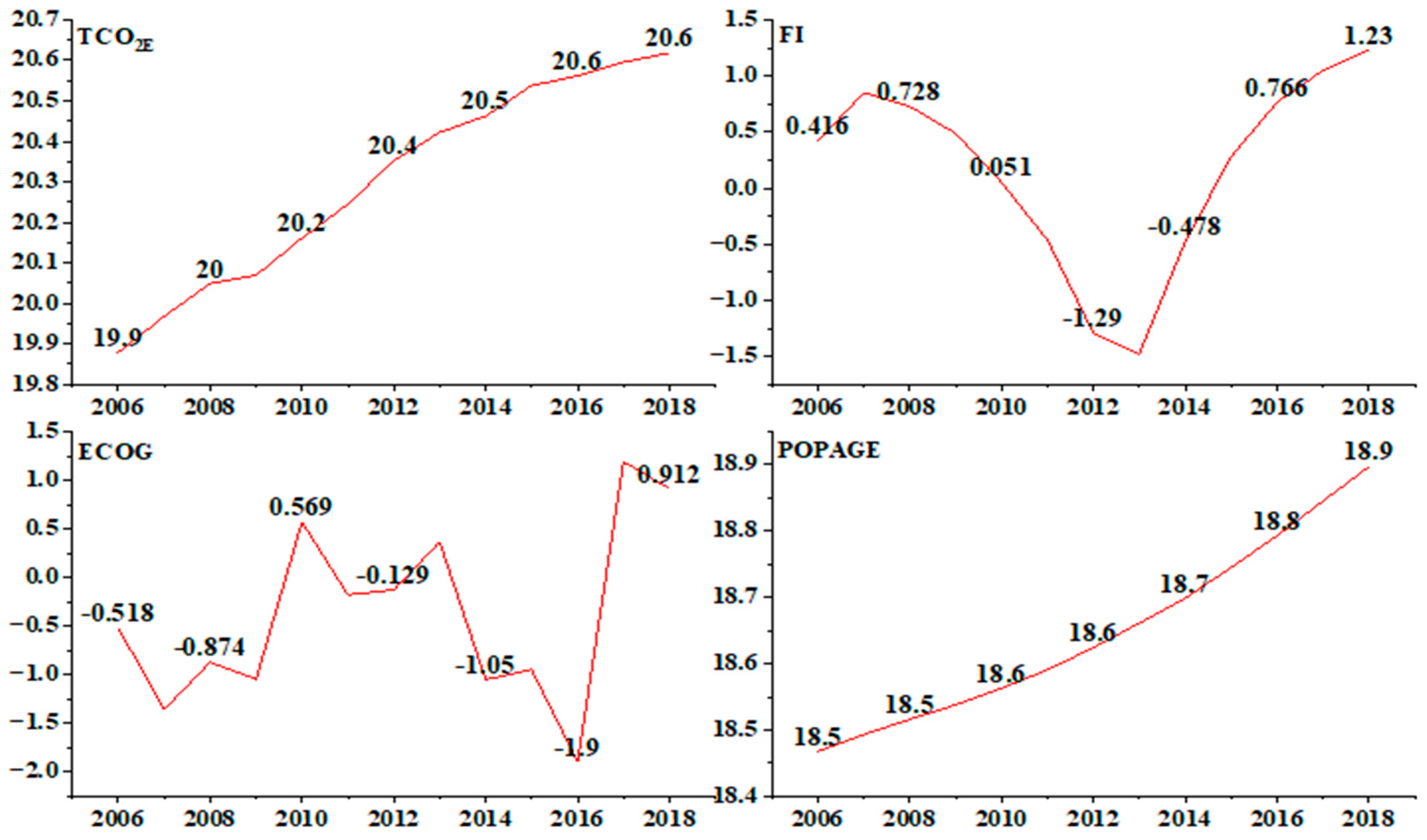
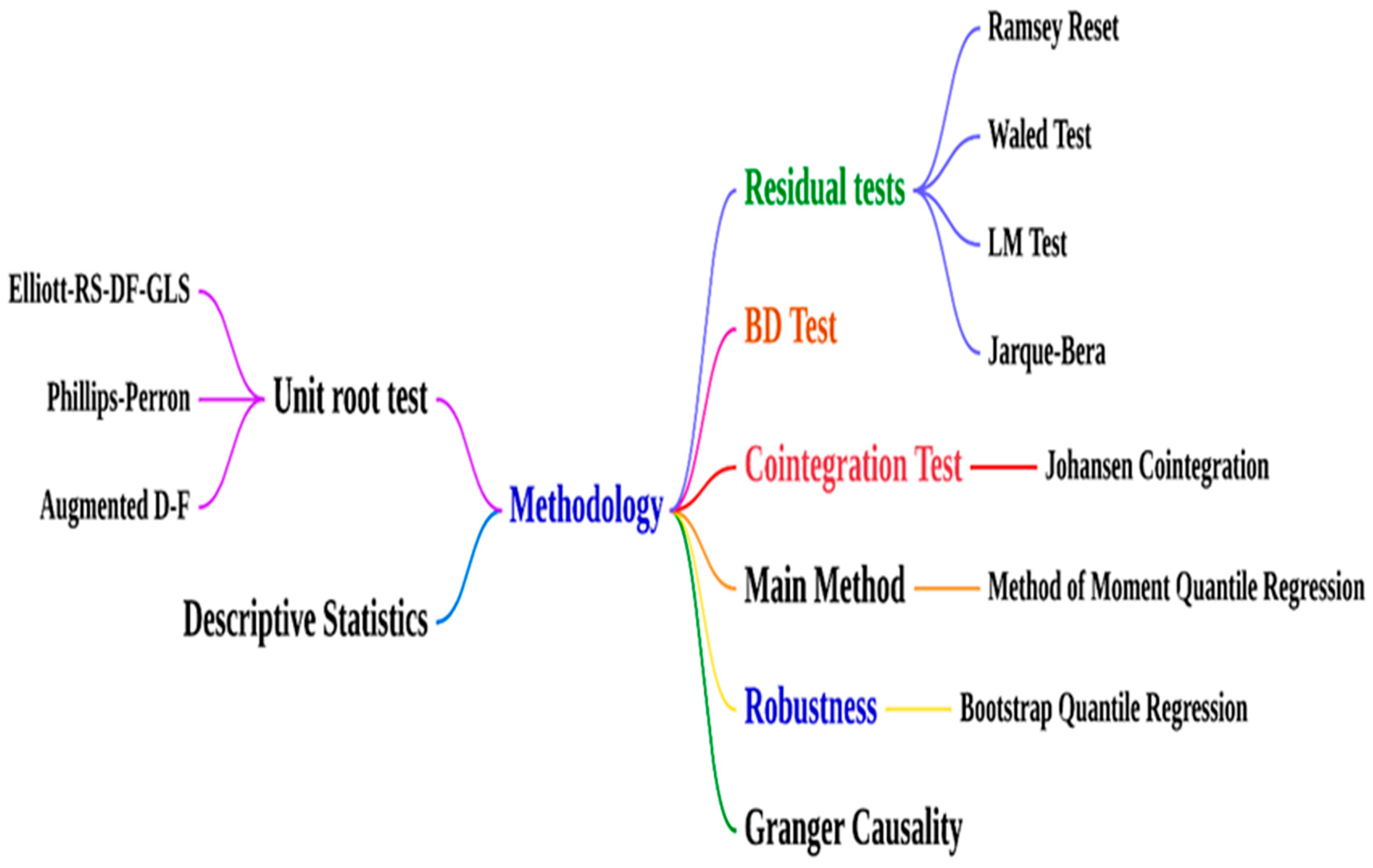
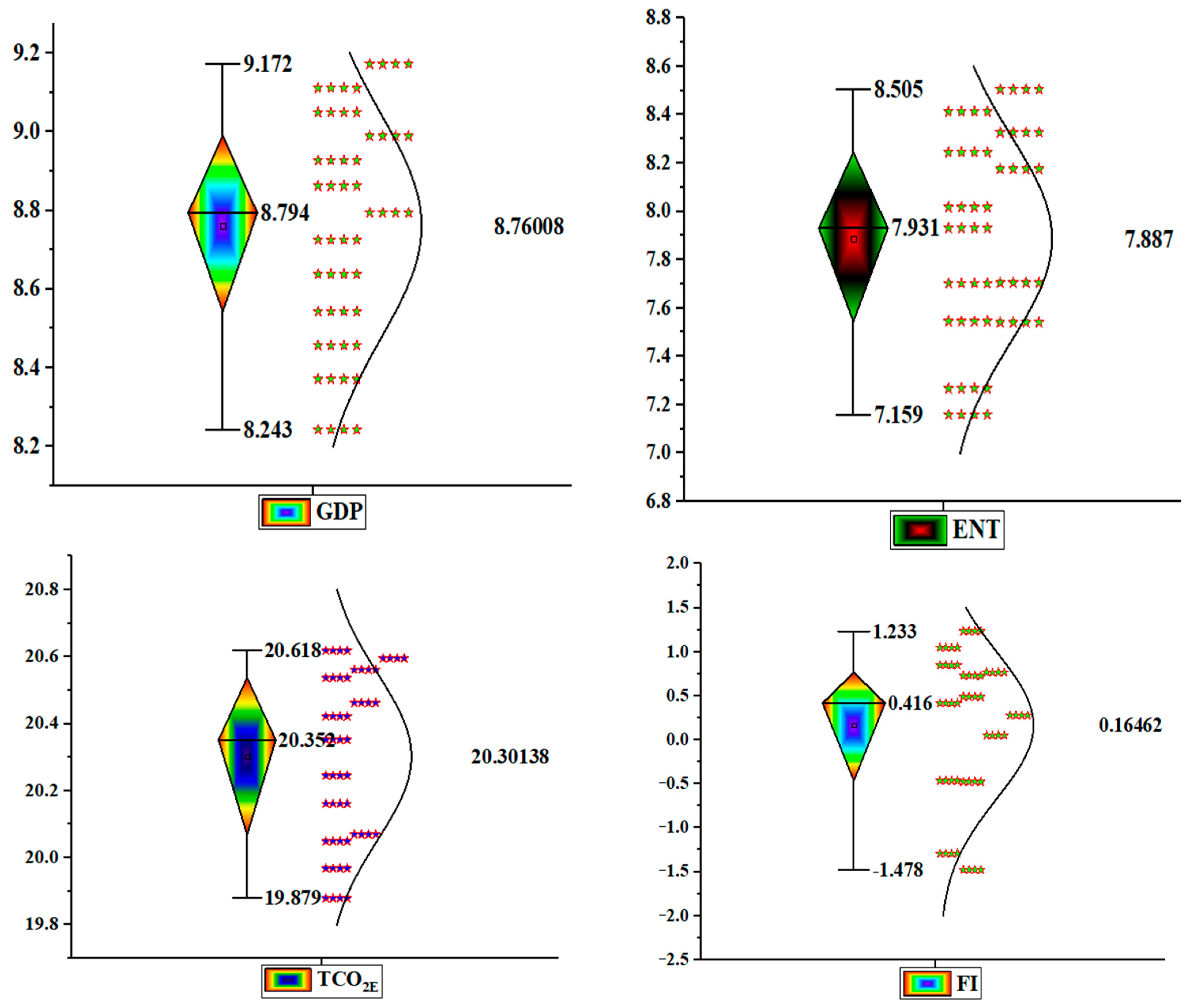
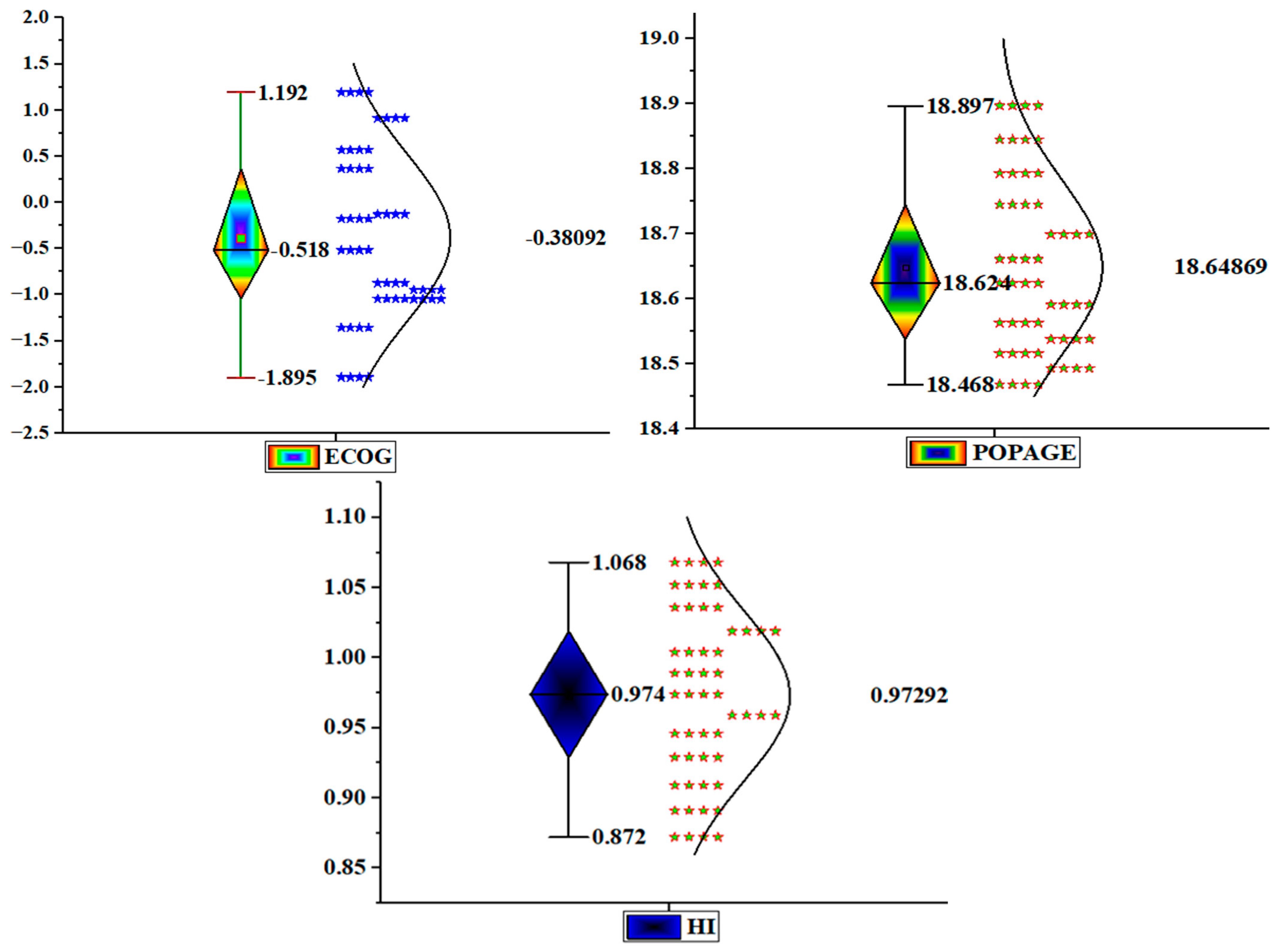
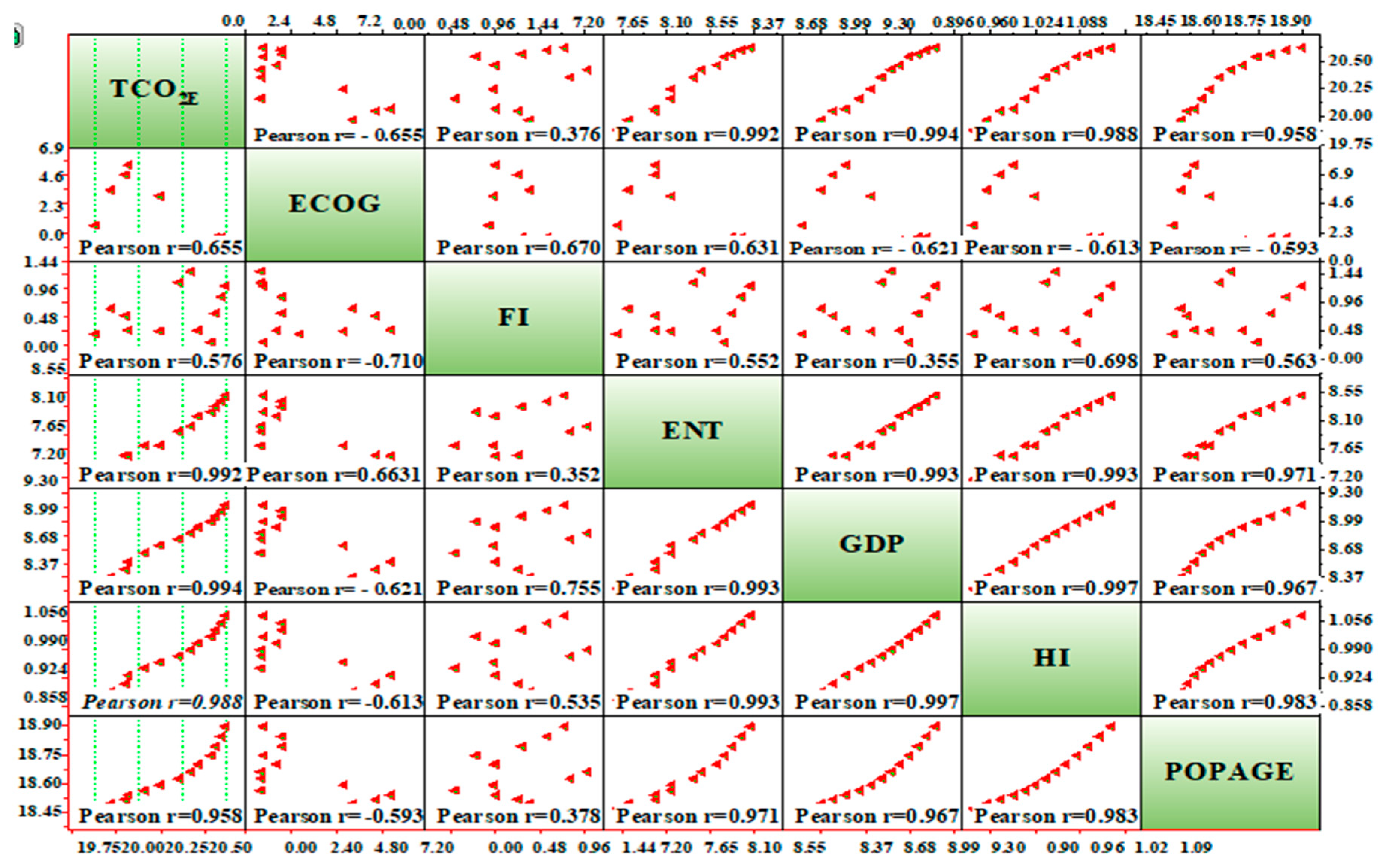
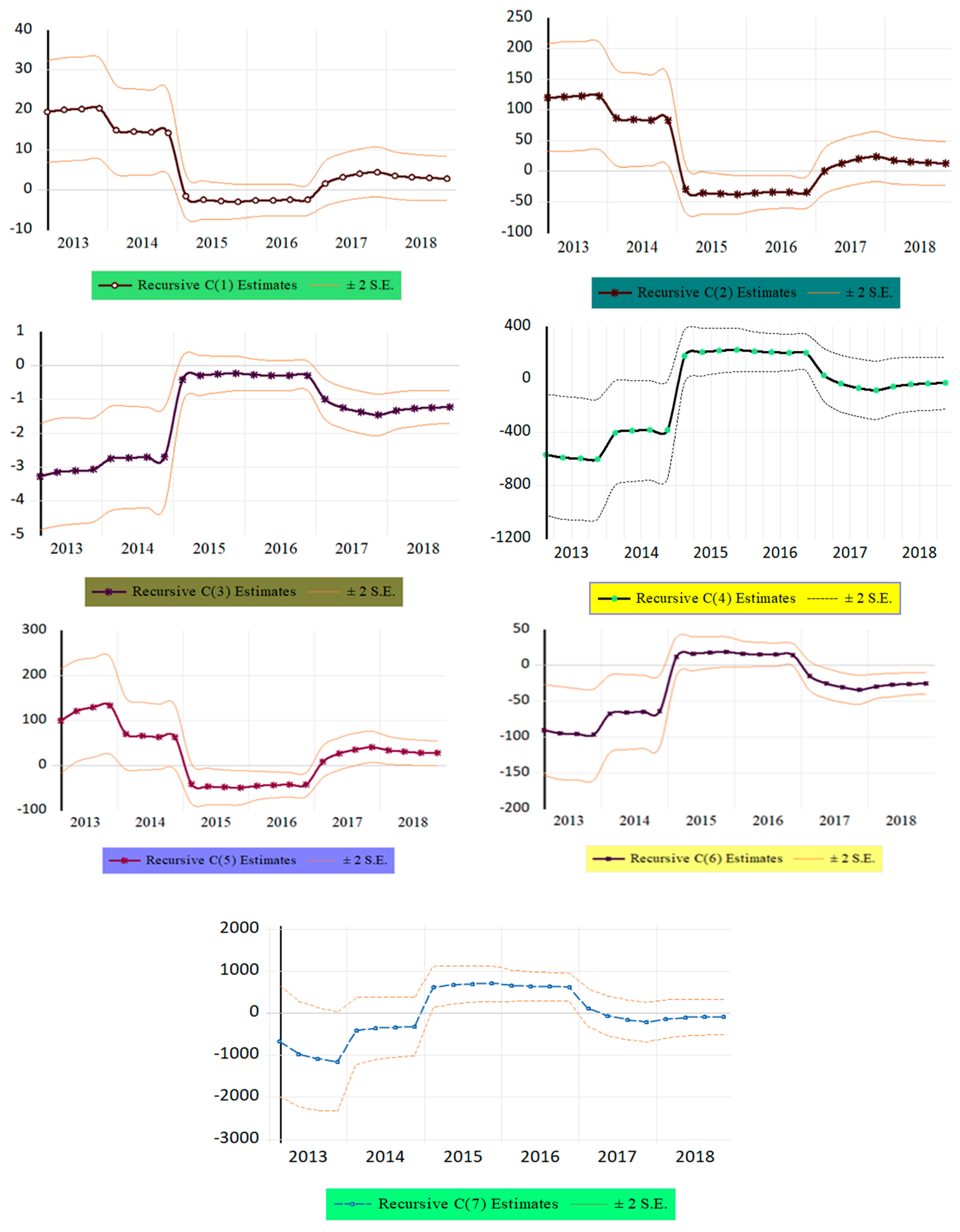

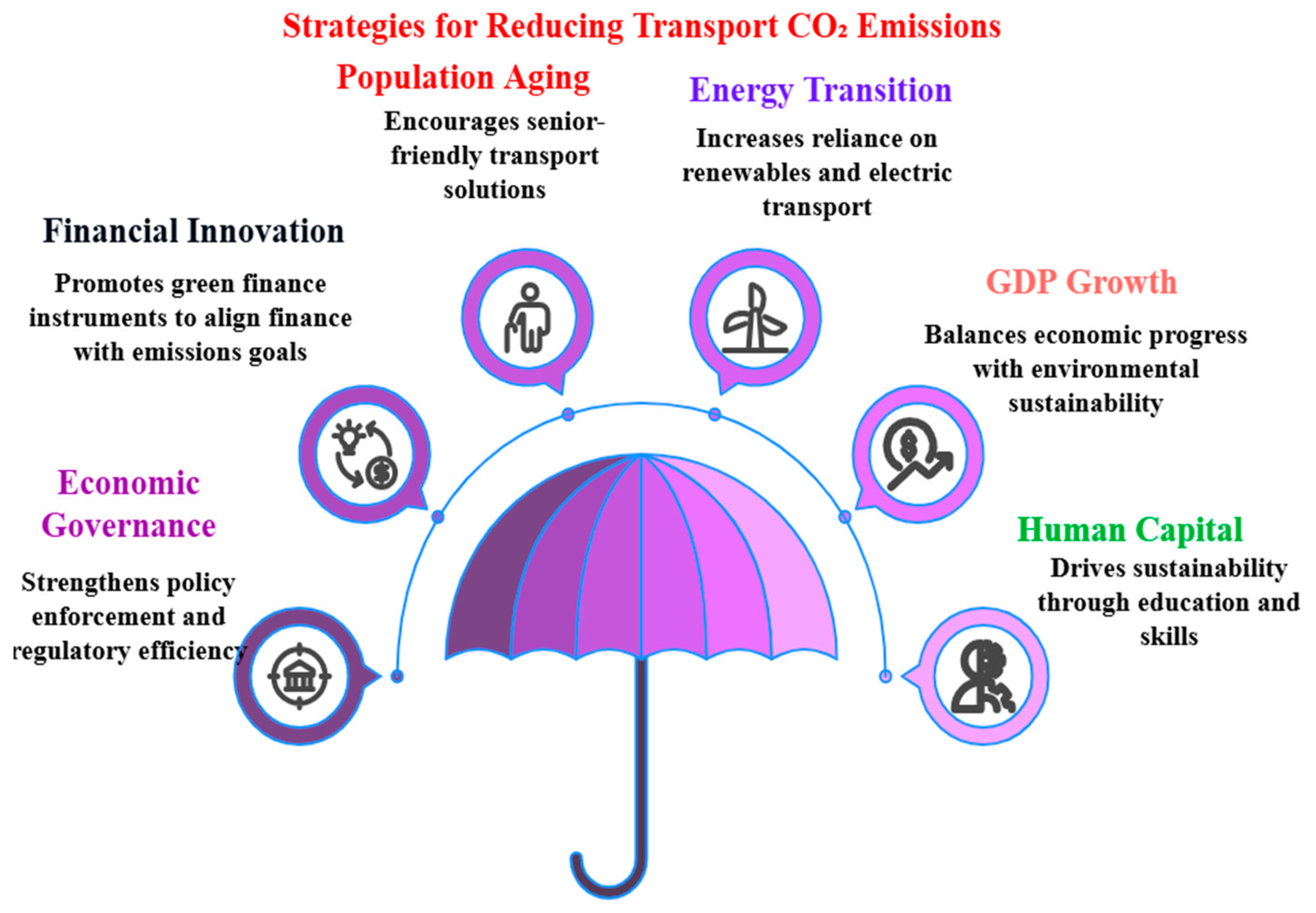
| Variables | Sign | Descriptions | Sources |
|---|---|---|---|
| Transport CO2 emissions | TCO2E | Mt per capita | OWD |
| Economic governance | ECOG | Regulatory quality, government effectiveness, and political stability | WDI |
| Population aging | POPAGE | Population ages 65 and above and % of the total population | WDI |
| Financial innovation | FI | Narrow money (M1) and broad money (M3), where M1 and M3 are measured as seasonally adjusted indices based on 2015 = 100, and M2 is automated teller machines (ATMs) (per 100,000 adults) | OECD WDI |
| Energy transition | ENT | % equivalent primary energy | OWD |
| Gross domestic product | GDP | Constant 2015 USD | WDI |
| Human capital index | HI | Based on the education ages and return to schooling | PWT 10 |
| TCO2E | ECOG | POPAGE | FI | GDP | HI | ENT | |
|---|---|---|---|---|---|---|---|
| Mean | 20.302 | −0.381 | 18.648 | 0.165 | 8.761 | 0.973 | 7.887 |
| Median | 20.352 | −0.518 | 18.624 | 0.416 | 8.794 | 0.974 | 7.931 |
| Maximum | 20.618 | 1.192 | 18.897 | 1.233 | 9.172 | 1.068 | 8.505 |
| Minimum | 19.879 | −1.895 | 18.468 | −1.478 | 8.243 | 0.872 | 7.159 |
| Std. Dev. | 0.247 | 0.904 | 0.135 | 0.835 | 0.286 | 0.061 | 0.425 |
| Skewness | −0.263 | 0.221 | 0.414 | −0.731 | −0.278 | −0.083 | −0.185 |
| Kurtosis | 1.648 | 2.006 | 1.949 | 2.384 | 1.914 | 1.894 | 1.824 |
| Phillips-P | ADF | ERS (DF-GLS) | ||||
|---|---|---|---|---|---|---|
| Variable | Level | 1st Difference | Level | 1st Difference | Level | 1st Difference |
| TCO2E | −1.588 | −9.511 a | −1.515 | −8.735 a | −0.028 | −1.819 b |
| POPAGE | 2.567 | −10.195 a | −1.633 | −8.368 a | 0.147 | −6.576 a |
| FI | −0.751 | −6.956 a | −2.268 | −6.956 a | −2.159 b | −1.688 c |
| ECOG | −2.323 | −6.945 a | −2.139 | −6.945 a | −2.174 b | −7.013 a |
| ENT | −1.266 | −15.442 a | −0.441 | −2.624 c | 1.067 | −2.304 b |
| GDP | −1.725 | −12.249 a | −1.979 | −2.912 b | 1.341 | −2.867 a |
| HI | −0.839 | −21.519 a | −0.526 | −9.155 a | 1.361 | −7.137 a |
| Dimension | TCO2E | ECOG | FI | POPAGE | HI | ENT | GDP |
|---|---|---|---|---|---|---|---|
| 2 | 0.197 a | 0.147 a | 0.167 a | 0.184 a | 0.189 a | 0.193 a | 0.194 a |
| 3 | 0.334 a | 0.222 a | 0.27 a | 0.303 a | 0.316 a | 0.322 a | 0.326 a |
| 4 | 0.429 a | 0.254 a | 0.332 a | 0.383 a | 0.405 a | 0.409 a | 0.421 a |
| 5 | 0.501a | 0.258 a | 0.363 a | 0.438 a | 0.469 a | 0.473 a | 0.491 a |
| 6 | 0.553 a | 0.249 | 0.376 a | 0.478 a | 0.526 a | 0.518 a | 0.546 a |
| Models | Values | Probability |
|---|---|---|
| ARCH test | ||
| χ2-statistic | 1.814 | 0.116 |
| LM test | ||
| χ2-statistic | 1.494 | 0.184 |
| Ramsey RESET test | ||
| F-statistic | 2.206 | 0.145 |
| Jarque–Bera test | ||
| F-statistic | 3.042 | 0.218 |
| Wald test | ||
| F-Statistic | 3540.346 a | 0.000 |
| (Trace) | ||||
| Hypothesized | Eigenvalue | Trace Statistic | 0.05 Critical Level | Prob. ** |
| None * | 0.974 | 350.412 | 150.558 | 0.000 |
| At most 1 * | 0.733 | 175.739 | 117.708 | 0.000 |
| At most 2 * | 0.567 | 112.388 | 88.804 | 0.000 |
| At most 3 * | 0.491 | 72.222 | 63.876 | 0.008 |
| At most 4 | 0.355 | 39.838 | 42.915 | 0.098 |
| At most 5 | 0.207 | 18.795 | 25.872 | 0.293 |
| At most 6 | 0.147 | 7.638 | 12.518 | 0.283 |
| (Maximum Eigenvalue) | ||||
| Hypothesized | Eigenvalue | Max-Eigen Statistic | 0.05 Critical Level | Prob. ** |
| None * | 0.974 | 174.672 | 50.599 | 0.000 |
| At most 1 * | 0.733 | 63.352 | 44.497 | 0.000 |
| At most 2 * | 0.567 | 40.166 | 38.331 | 0.031 |
| At most 3 * | 0.491 | 32.383 | 32.118 | 0.046 |
| At most 4 | 0.355 | 21.043 | 25.823 | 0.188 |
| At most 5 | 0.207 | 11.157 | 19.387 | 0.497 |
| At most 6 | 0.147 | 7.638 | 12.518 | 0.282 |
| Variables | Impact on CO2 Emissions | Numerical Results (MMQR Coefficients) | Policy Recommendations |
|---|---|---|---|
| ECOG | ↓ Reduces emissions | −0.008 (Q0.50), −0.008 (Q0.75) | Strengthen regulations and improve governance effectiveness |
| FI | ↑ Increases emissions | 0.025 (Q0.50), 0.026 (Q0.90) | Promote green finance and limit funding to carbon-intensive projects |
| POPAGE | ↑ Increases emissions | 1.368 (Q0.25), 1.901 (Q0.90) | Implement senior-friendly low-carbon transport solutions |
| ENT | ↓ Reduces emissions | −0.235 (Q0.50), −0.326 (Q0.90) | Expand renewable energy use and support electric vehicles |
| GDP | ↑ Increases emissions | 1.65 (Q0.50), 1.889 (Q0.90) | Balance economic growth with sustainability policies |
| HI | ↓ Reduces emissions | −8.305 (Q0.50), −11.094 (Q0.90) | Invest in education, green technology, and R&D |
| Quantiles | ||||||
|---|---|---|---|---|---|---|
| Variables | Location | Scale | Q0.25 | Q0.50 | Q0.75 | Q0.90 |
| ECOG | −0.008 a | 0.0001 a | −0.008 a | −0.008 a | −0.008 c | −0.008 a |
| FI | 0.025 a | 0.001 a | 0.024 a | 0.025 a | 0.025 a | 0.026 b |
| POPAGE | 1.368 a | 0.233 a | 1.199 a | 1.331 a | 1.557 a | 1.901 a |
| ENT | −0.235 a | −0.041 a | −0.205 a | −0.228 a | −0.267 a | −0.326 a |
| GDP | 1.65 a | 0.103 a | 1.581 a | 1.638 a | 1.738 a | 1.889 a |
| HI | −8.305 a | −1.219 c | −7.421 a | −8.109 a | −9.292 a | −11.094 a |
| Cont… | −13.478 a | −4.365 a | −10.309 a | −12.779 a | −17.011 a | −23.465 a |
| Quantile | ||||
|---|---|---|---|---|
| Variables | Q 0.25 | Q 0.50 | Q 0.75 | Q 0.90 |
| ECOG | −0.005 a | −0.006 a | −0.006 c | −0.013 a |
| FI | 0.031 a | 0.029 a | 0.029 a | 0.151 c |
| POPAGE | 1.239 a | 1.489 a | 1.489 a | 1.952 c |
| ENT | −0.234 a | −0.205 a | −0.205 a | −0.358 b |
| GDP | 1.353 a | 1.468 a | 1.468 a | 2.409 c |
| HI | −6.737 a | −7.451 a | −7.451 a | −13.979 c |
| Constant | −9.947 a | −14.693 a | −14.693 a | −26.403 a |
| Null Hypothesis | F-Statistic | Prob |
|---|---|---|
| ECOG–TCO2E | 3.772 a | 0.008 |
| TCO2E–ECOG | 0.290 | 0.982 |
| POPAGE–NTCO2E | 3.583 | 0.011 b |
| TCO2E–POPAGE | 1.081 | 0.436 |
| FI–TCO2E | 0.716 | 0.717 |
| TCO2E–FI | 0.137 | 0.999 |
| ENT–TCO2E | 40.734 | 3.009 |
| TCO2E–ENT | 4.396 a | 0.004 |
| GDP–TCO2E | 1.663 | 0.175 |
| TCO2E–GDP | 5.958 a | 0.000 |
| HCI–TCO2E | 15.592 | 2.006 |
| TCO2E–HI | 0.947 | 0.531 |
| POPAGE–ECOG | 0.359 | 0.959 |
| ECOG–POPAGE | 2.308 c | 0.064 |
| FI–ECOG | 0.391 | 0.946 |
| ECOG–FI | 2.890 b | 0.028 |
| ENT–ECOG | 0.384 | 0.949 |
| ECOG–ENT | 1.244 | 0.340 |
| GDP–ECOG | 0.227 | 0.993 |
| ECOG–GDP | 5.459 a | 0.002 |
| HI–ECOG | 0.512 | 0.876 |
| ECOG–HI | 0.059 | 1.000 |
| FI–POPAGE | 1.227 | 0.348 |
| POPAGE–FI | 1.422 | 0.257 |
| ENT–POPAGE | 3.063 b | 0.022 |
| POPAGE–ENT | 1.099 | 0.424 |
| GDP–POPAGE | 1.437 | 0.251 |
| POPAGE–GDP | 12.689 | 9.006 |
| HI–POPAGE | 1.789 | 0.143 |
| POPAGE–HI | 10.054 | 4.005 |
| ENT–FI | 1.919 | 0.116 |
| FI–ENT | 1.214 | 0.356 |
| GDP–FI | 0.299 | 0.979 |
| FI–GDP | 17.356 | 1.006 |
| HI-FI | 2.469 b | 0.051 |
| FI–HI | 1.073 | 0.442 |
| GDP–ENT | 10.869 | 3.005 |
| ENT–GDP | 1.428 | 0.254 |
| HI–ENT | 8.869 | 9.005 |
| ENT–HI | 0.617 | 0.798 |
| HI–GDP | 24.306 | 1.007 |
| GDP–HI | 8.097 a | 0.000 |
Disclaimer/Publisher’s Note: The statements, opinions and data contained in all publications are solely those of the individual author(s) and contributor(s) and not of MDPI and/or the editor(s). MDPI and/or the editor(s) disclaim responsibility for any injury to people or property resulting from any ideas, methods, instructions or products referred to in the content. |
© 2025 by the authors. Licensee MDPI, Basel, Switzerland. This article is an open access article distributed under the terms and conditions of the Creative Commons Attribution (CC BY) license (https://creativecommons.org/licenses/by/4.0/).
Share and Cite
Wu, H.; Du, J.; Rasool, Y. Navigating Environmental Concerns: Unveiling the Role of Economic Governance, Energy Transition, and Population Aging on Transport-Based CO2 Emissions in China. Energies 2025, 18, 1748. https://doi.org/10.3390/en18071748
Wu H, Du J, Rasool Y. Navigating Environmental Concerns: Unveiling the Role of Economic Governance, Energy Transition, and Population Aging on Transport-Based CO2 Emissions in China. Energies. 2025; 18(7):1748. https://doi.org/10.3390/en18071748
Chicago/Turabian StyleWu, Huan, Jianguo Du, and Yasir Rasool. 2025. "Navigating Environmental Concerns: Unveiling the Role of Economic Governance, Energy Transition, and Population Aging on Transport-Based CO2 Emissions in China" Energies 18, no. 7: 1748. https://doi.org/10.3390/en18071748
APA StyleWu, H., Du, J., & Rasool, Y. (2025). Navigating Environmental Concerns: Unveiling the Role of Economic Governance, Energy Transition, and Population Aging on Transport-Based CO2 Emissions in China. Energies, 18(7), 1748. https://doi.org/10.3390/en18071748







